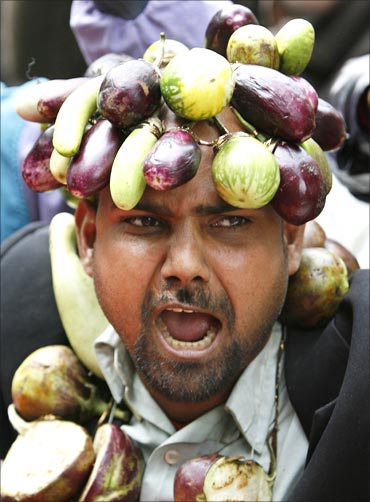
One piece of bread a day / Was all I had,
Sometimes I would break it in half,
Sometimes, I could make it toast,
My children's bellies full / My stomach churning,
I drank water / To calm the burning,
I had more than most / Reminding myself of those,
Who have a handful of rice / Once a week,
They know fear / They know pain,
They know hunger / Far better than I ever could.
Alisha Rose's poem, Hunger, brings out the essence of a grave problem that plagues not only India, but the entire world.
According to the Global Hunger Index, India ranks 65th out of 88 countries, with a hunger rate of 23.9.
India, which was largely unaffected by the recent global economic slowdown, however, appears to have made little progress in tackling hunger and malnutrition. The situation remains 'alarming' in the country on this front.
Countries like Uganda (38th); Mauritania (40th); Zimbabwe (58th) and many others have a better record than India on this front. Even war-torn nations have managed to combat the scourge of hunger quite well, while India -- even though it boasts of being the second fastest growing economy in the world -- languishes far behind and millions in the country go hungry.
. . .

21 per cent of the Indian population is undernourished
The report -- released on Wednesday by the International Food Policy Research Institute, German aid group Welthungerhilfe and Irish aid group Concern Worldwide -- said that the number of malnourished people was rising as a result of recent events.
"The current situation of food crisis, financial crunch and global recession has further undermined the food security and the livelihoods of the poor," it said.
The index ranks countries on under-nourishment, prevalence of child malnutrition and rates of child mortality.
It said 21 per cent of the Indian population was undernourished (between 2003 and 2005), 43.5 per cent Indian children under the age of five were underweight (between 2002 and 2007) and the under five-years age infant mortality rate in 2007 was 7.2 per cent.
46% of Indian children below the age of 5 are underweight
In September 2009, Prime Minister Manmohan Singh projected a food stock of 50 million tonne. Yet, close to 300 million Indians go without food every day!
India continues to burnish its international image with initiatives like Brand India, a public-private campaign whose stated mission is to 'build positive perceptions of India globally'.
But when the prime minister acknowledged the country's undernourished children as a 'national shame', the statement highlighted how India's economic success co-exists with its persistently high rates for hunger, malnutrition, and income poverty.
According to the World Bank, 46 per cent of Indian children below the age of five are underweight, and the World Food Program says that close to 30 per cent of the world's hungry live in India.
. . .
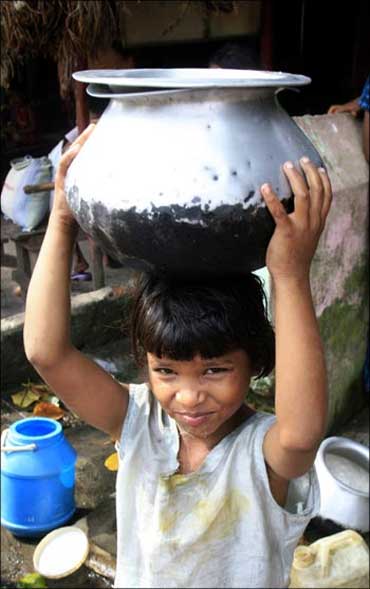
Does solution lie in biodiverse ecosystems?
According to a recent report in The Hindu, biodiverse ecosystems contain naturally evolved genetic strengths and unique food technologies developed by traditional communities in different climates, soils and temperatures. Harnessing and sharing these capabilities equitably will help humanity adapt to rising temperatures and the poorest of the poor feed themselves in harsh climates.
To that end, the Chennai Declaration set out a series of strategies that are the product of three days of intense discussion, at the M.S Swaminathan Research Foundation, of the senior representatives from organisations across the world such as the UN Environment Programme, UN Food and Agricultural Organisation, International Rice Research Institute, International Fund for Agricultural Development, World Food Prize Fund, and India's National Biodiversity Authority and Ministry of Environment and Forests.
"The declaration makes a bridge of issues at global, national and local levels between the challenges for conservation and food security," said Angela Cropper, deputy executive director, UN Environment Programme.
These include: according economic value to the services nature and agriculture rendered and setting up mechanisms for payment for such services; acknowledging that the custodians of biodiverse resources are farmers and fisherfolk; finding markets for neglected but nutritious crops; including rural communities in biodiversity strategies; refocussing research and development priorities and promoting biodiversity literacy through public education to build an ethic of conservation.
Jairam Ramesh, Union Minister of State for Environment and Forests, present at the valedictory session, pledged to take forward the 'wonderful ideas' contained in the declaration.
He said he would do his best to integrate climate change mitigation strategies with biodiversity conservation in both national policy and in international discussion in Mexico later this year. 2010 is the International Year of Biodiversity.
...

India leads the world in hunger
Despite its economic successes, India leads the world in hunger. According to the 2008 Global Hunger Index, which is calculated by the International Food Policy Research Institute, India has close to 350 million people who are food insecure -- in other words, who are not sure where their next meal will come from.
To put that into context, that is the same as the entire populations of Germany, France and the United Kingdom all going hungry.
The UN's Food and Agriculture Organisation believes that over 1 billion people will go hungry in 2009.
Almost 100 million (10 per cent) of those have been made newly hungry by the Financial Crisis. By that grim calculus, India's hungry have grown to at least 300 million, with India providing 30 per cent of the world count.
India is the second most populated country in the world. With a population of 1.173 billion, the hungry make up over 25 per cent or one in four in the country. The percentage is probably better than it was fifty years ago, but the absolute number is growing.
Compare this to China, which has a larger population (1.334 billion) and which 50 years ago was arguably poorer.
It has managed to bring over 500 people out of poverty, its hungry count is today less than 100 million, and that number is shrinking every year.
. . .
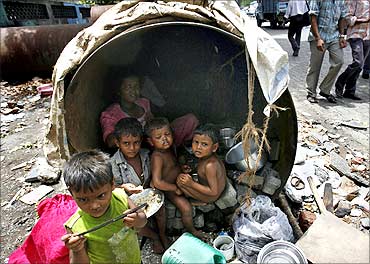
What ails India?
In an article in EconomyWatch.com, Dwayne Ramakrishnan wrote, 'Endemic problems such as corruption, poor infrastructure and a lack of access to funds continue to be a problem in India.'
The Congress government has been put a strong focus on this area, for example allocating funds to go directly to villages rather than through often corrupt local officials. It was one of the reasons that Congress won the elections with such a show of force - but more clearly needs to be done.
2009 has been a particularly disasterous year for Indian farmers. First there was there was the monsoon failure, he said.
It is estimated that this knocked out 40-50 per cent of the Kharif monsoon harvest.
Then at the end of the monsoon season, which is normally dry, there were torrential downpours.
Although this solved the water crisis, it made the food crisis worse, as much of the crops that made it through the drought were destroyed.
. . .

Key solution lies in technology
According to Ramakrishnan, the FAO believes that the supply of available arable land is running out. At the same time, farmers are either getting diminishing returns from their current land, or they are having to put ever more inputs to get the same yield.
Much of the progress in feed the world since the 1970's has been thanks to the Green Revolution, pioneered by Norman Borlaug, who helped the Mexicans to vastly increase their crop yields.
He then took this technology worldwide, with fantastic results in India and many other nations. Sadly, Mr Borlaug passed on the 12 September 2009.
The Green Revolution relied on high-yielding crop varieties, together with fertilisers and other methods to more than double crop yields.
Since that great productivity burst, however, technology has stagnated.
There is a great deal that newer technology can offer. New crop varieties are being developed that require considerably less water and nitrogen. Lasers can be used to flatten fields, and sprinklers can greatly reduce water wastage.
Governments in India and elsewhere need to focus on a second Green Revolution to create another quantum leap in productivity.
We need to get back on the path of hunger reduction that we were -- until recently -- so successfully treading. Otherwise the food riots of last year and doubling of potato and lentil prices this year will seem like - pardon the pun - chicken feed.
. . .
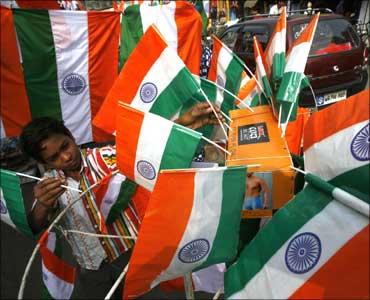
Bric agriculture ministers to discuss food security
A recent PTI report stated that ways to pool efforts to ensure global food security were discussed at the first-ever meeting of agriculture ministers of the dynamically growing grouping of Brazil, Russia, India and China in Moscow on March 26.
India is represented by Agriculture Minister Sharad Pawar.
"The agriculture ministers of BRIC nations are to discuss issues related to the food security and role of information exchange in optimising their agricultural development, including mitigation of negative impact of climate change on it, by way of modernisation," a Russian agriculture ministry release said ahead of the meeting.
With a total population of 2.83 billion, BRIC nations jointly produce 40 per cent of wheat and are a source of 50 per cent pork and more than 30 per cent of poultry meat in the world.
The four nations are home to 42 per cent of the global population and 32 per cent of the arable land.
The BRIC agriculture ministers are also expected to discuss the problem of import restrictions in their countries on the agricultural produce and ways to remove them by adopting mutually acceptable standards of quality control.
Experts here noted that the BRIC group of fastest emerging economies would impart dynamism to the positive development of global economy.
At the end of their one-day session, the BRIC agriculture ministers are expected to adopt a joint declaration and interact with the local business community.
. . .
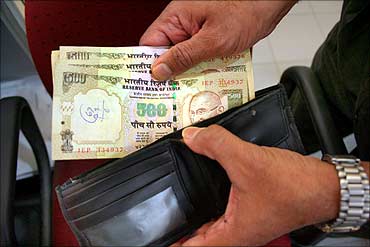
Increased prices led to food insecurity
Rising food prices contributed to a significant increase in food insecurity worldwide, particularly among poorer populations. Approximately 1 billion people -- or one sixth of the world's population -- subsist on less than $1 per day.
Of this population, 162 million survive on less than $0.50 per day. At the household level, increasing food prices have the greatest effect on poor and food-insecure populations, who spend 50 to 60 percent or more of their income on food, according to the International Food Policy Research Institute.
Overall, increased food prices particularly affect developing countries, and the poorest people within those countries, where populations spend a larger proportional share of income on basic food commodities.
. . .

Is India's prosperity one of the causes?
Prosperity in countries like India is good but it triggers increased demand for better nutrition, which in turn leads to higher food prices, former US President George W Bush said in 2008, leading to a major hue and cry.
Prior to this, then US secretary of state Condoleezza Rice too had stated that 'apparent improvement' in the diets of people in India and China and consequent food export caps is among the causes of the current global food crisis.
Bush argued that there are many factors for the present crisis, only one of which was investment on biofuels like ethanol.
"Worldwide, there is increasing demand. There turns out to be prosperity in developing world, which is good. It's going to be good for you because you'll be selling products in the countries, you know, big countries perhaps, and it's hard to sell products into countries that aren't prosperous. In other words, the more prosperous the world is, the more opportunity there is," Bush had said.
"It also, however, increases demand. So, for example, just as an interesting thought for you, there are 350 million people in India who are classified as middle class. That's bigger than America. Their middle class is larger than our entire population."
"And when you start getting wealth, you start demanding better nutrition and better food, and so demand is high, and that causes the price to go up," he said.
Bush also listed change in weather patterns and increase in basic costs like that of energy as factors contributing to higher food prices.
. . .
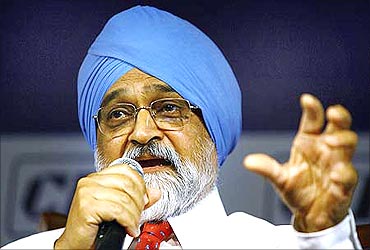
What actually led to the crisis
Several factors contributed to the rapid spike in global food prices. These are:
Subsequently, a significant increase in world cereal production in 2008 led to improved global cereal stocks and an associated reduction in the international prices of most cereals, representing a 50 per cent decrease in many cases since May 2008.
However, food prices remain high in most developing countries.
According to the UN Food and Agriculture Organization, food emergencies, resulting from the combined effects of chronic food insecurity and high food price levels, persist in 31 countries, including 20 African nations.
In an article in The Hindu M S Swaminathan, Member of Parliament (Rajya Sabha) and former chairman, National Commission on Farmers, wrote:
With a population of over 1.1 billion, India's agricultural strategy should aim to keep the Central and State governments in a commanding position with reference to the management of food distribution systems such as PDS, Integrated Child Development Services, and school noon meal programme.
In the ultimate analysis, assured and remunerative marketing will hold the key to stimulate and sustain farmers' interest in producing for the market. Climate change may result in adverse changes in temperature, precipitation and sea level.
Dependence only on wheat and rice will enhance vulnerability to climatic factors.
Therefore, there should be revitalisation of the earlier food traditions of rural and tribal families, who in the past depended for their daily bread on a wide range of millets, grain legumes, tubers and vegetables.
The PDS should include, wherever appropriate, ragi and a wide range of nutritious cereals, inappropriately referred to as coarse cereals, and tubers.
India has the technological and economic capability to demonstrate how farming systems can be adjusted to different weather patterns.
. . .

Corruption in public distribution system causing starvation deaths
The prime minister of India in his foreword in the Report to The People dated May 22, 2007, claimed: "In this 60th year of independence, the country should have the satisfaction of recording for the fifth year in a succession a rate of economic growth of over 8.5 per cent."
The Asian Legal Resource Centre, however, is not sure whether the estimated over 200 million Indians who are presently suffering from malnourishment, and the many more million who have done so during past decades, will be satisfied with this growth.
The country's overwhelming population is often given as an excuse to justify poverty and starvation in India.
This theory is applicable only if the state itself is poor and has no means to procure enough food for its people. India is not poor, even though 70 per cent of Indians are.
Defense spending of huge proportions in a country where a section of the population equivalent to 2/3rds the size of that of the United States is undernourished or suffering from malnourishment, is difficult to stomach.
The United Nations Special Rapporteur on the Right to Food has highlighted this contradiction of priorities in his report following his mission to India in 2005.
The management of the public distribution system suffers from corruption particularly black marketing, caste prejudices and the utter failure of various local governments.
This is because the longer the people remain poor and near starvation, the easier it is for the village-head to continue subjecting them to bonded labour.
The actual number of households using the PDS is around 91 million, significantly less than the 160 million being claimed by the government. Seventy-eight per cent of these persons are trying to make use of the system -- 26 per cent are from urban areas while 52 per cent are rural households.
Of these 91 million households an alarming 61 per cent claim that the PDS is plagued by corruption and 49 per cent claim that corruption has increased in the past year.
The PDS is viewed as the most corrupt institution in India.
. . .
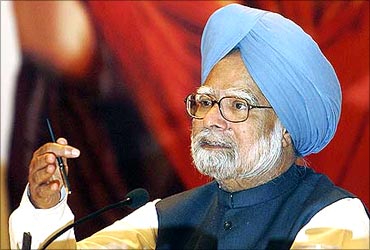
What needs to be done: A few suggestions
The Asian Legal Resource Centre requests the Human Rights Council to:
This mechanism must be independent from the local police, as the latter is corrupt and therefore inefficient in investigating corruption.
This requires a change in the existing domestic law -- The Essential Commodities Act, 1955, and the government of India must be urged to make such changes and facilitate this process;